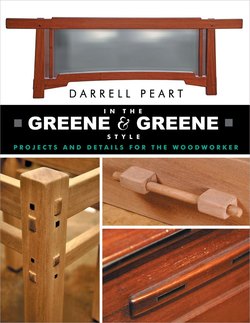Читать книгу In the Greene & Greene Style - Darrell Peart - Страница 8
На сайте Литреса книга снята с продажи.
ОглавлениеChapter 3
The Block & Dowel Pull
The block and dowel pull is not an original Greene & Greene detail. It is something I unwittingly borrowed from James Krenov’s work and added to my design vocabulary. Krenov has been a large secondary influence on my work and his pull is not the only one of his details that I have incorporated into my own designs.
There is good reason to include this non-Greene & Greene detail here. For good or bad, the block and dowel pull has become a part of the woodworking world’s G & G vocabulary. It shows up regularly in projects done “in the style of Greene & Greene,” and I am often asked about its construction.
In both this book and my previous one, I have encouraged my readers to “branch out on their own.” That is, to take from Greene & Greene what you will, and augment to that whatever inspires you. But “mixing and matching” must be done with forethought, lest you end up with Franken-furniture. Merging the block and dowel pull with Greene & Greene is a good exercise in “mixing and matching.” I like to think of furniture design in terms of DNA. In this scenario, the building blocks of design are all infused with a common construction thread. When a new element is introduced it can only be synthesized with the material and tools on hand. Every detail appears to have come from the same source. So the question becomes, if it were Greene & Greene DNA building the Krenov pull, how would it be done and what would it look like?
The block and dowel pull was originally a James Krenov detail.
Krenov, like the Greenes, made most if not all of his pulls in the shop. The block-and-dowel pulls’ exposed joinery and practical nature is something the DNA of Greene & Greene and Krenov have in common. But there is a key difference as well. The building blocks for a Greene & Greene creation call for the rounding over and softening of all exposed corners and surfaces, much more so than that of Krenov. So, by way of a little “genetic engineering,” all the sharp edges of the pull get a healthy softening and round over prior to the Greene & Greene adaptation. Added to this I relied upon my intuition and made the block a bit longer and more rectangular in shape, than the mostly square, original, Krenov pull.
The Freemont Nightstand with ebony blocks (block and dowel pull). Photo by Darrell Peart.
Like the G & G arched pull, also discussed in this book, or for that matter any design detail, the context will determine the sizing as well as some of the secondary details. The exercise given here is but a starting point and somewhat generic in sizing. I have made this pull in several variations.
To accommodate the wide horizontal drawer front of a lateral file, I increased the dowel size to a hefty ½", made the pull much longer, and added a third center block. In another wide drawer situation, that of a large chest of drawers, I opted instead to go with two standard sized pulls, spaced to line up with the pulls of two smaller upper drawers. The double pulls in this situation also invite the user to use both hands, therefore lessening the chance of binding the wooden runners.
I have on occasion used ebony for the blocks. This can sometimes break up the tedium of an otherwise monotone face and add detail. Be cautious if using ebony as it is very brittle and not happy with some of the machining operations. This will be discussed in detail later.
Another variable is the length of the block and its relative position from the end of the dowel. The 1¼" block length and ½" set back from the end is by no means sacrosanct. They are good default settings, but don’t make them sacred.
My first attempts at constructing this pull were not without a couple of minor challenges. Challenges are one of the things that make woodworking fun though. If it were too easy it would cease to hold our interest.
1. Round-over the end of the dowel.
2. Blend the rounded ends.
3. Add a 1⁄8" radius.
Getting Started—The Doweled Rod
To start with, familiarize yourself with the drawing of the pull (drawing A), then cut a 3⁄8" dowel to a length of 6". To round over the end of the dowel, set up a router table with a 1⁄8" round over bit. Line up the middle of the dowel rod with the middle of the bit’s bearing and clamp a piece of thin sheet stock (¼" or less) in place to save the registration. To perform the operation, place the dowel against the registration piece with the end in contact with the bearing, and then use your fingers to rotate the dowel one full revolution. Blend the rounded ends of the dowel with 220-grit sandpaper using a “flapping” motion backed up by your thumb. Finish sanding the rest of the rod to 220-grit, then set the finished dowel part aside for now.
